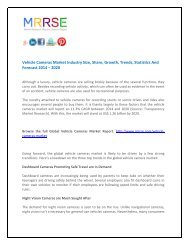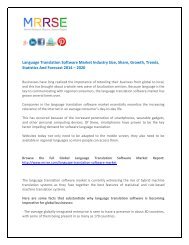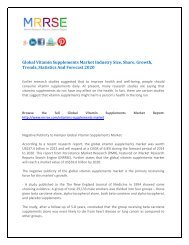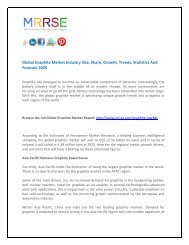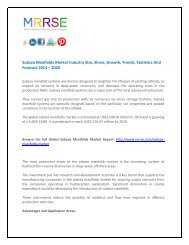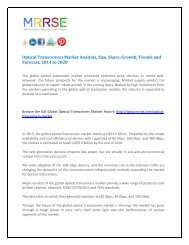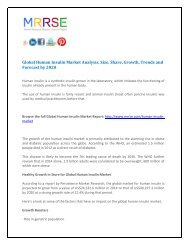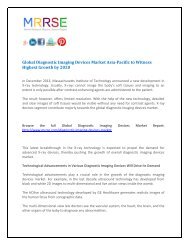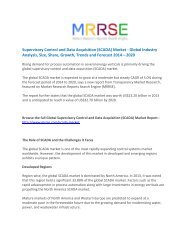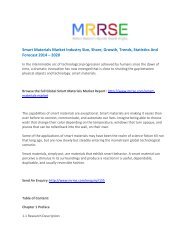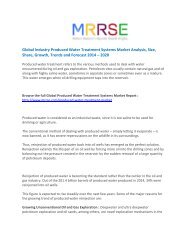o_19o5id6hh11bl1oorolu1pkc1edva.pdf
Create successful ePaper yourself
Turn your PDF publications into a flip-book with our unique Google optimized e-Paper software.
Frontier Pharma Parkinsons Disease - Identifying and Commercializing First-in-<br />
Class Innovation Analysis & Forecast<br />
In the United States, almost 1.5 million people are reported to be affected by Parkinson’s<br />
disease (PD), wherein 60,000 patients continue to be diagnosed with the condition every year,<br />
costing the U.S. economy US$14 billion on an annual basis in the direct and indirect expenses.<br />
Browse the full Global Parkinson’s Disease Market Report : http://www.mrrse.com/frontierpharma-parkinsons-disease<br />
At present, 302 products are being actively developed in the therapeutic pipeline of<br />
Parkinson’s disease over a number of stages.<br />
However, the mechanisms of action applied on the existing products compared to the ones in<br />
the pipeline shows severe differences. The existing symptomatic treatments employed for PD<br />
target neuromodulatory receptors; whereas, the current product pipeline features a<br />
widespread array of neuroprotective therapies focusing on dysfunctional disease procedures.<br />
The availability of ninety first-in-class products that holds 37% of the overall therapies in<br />
pipeline is one of the major reason behind the diversity in the MoA for both, existing products<br />
and pipeline products.<br />
Since, the global PD industry is driven by first-in-class products compared to the non-first-inclass<br />
ones; the development of this market is widely impacted by this factor. Although the<br />
first-in-class products and therapies have indicated high abrasion rate in past, they have the<br />
potential to modify the global PD treatment market for good.<br />
As the global market for Parkinson’s disease is rising at a rapid pace, let’s take a look at the<br />
future prospects the market is going to deal with:<br />
· The overall revenue generated from sales in the PD markets of the U.S., Germany, France,<br />
Italy, the U.K., Spain, and Japan is expected to register a slight decline from around US$2.7<br />
billion in 2010 to an estimate of US$2.6 billion by 2020.
· The dominant dopamine agonists, ropinirole and pramipexole, are expected to trigger the<br />
sales significantly. The increasing usage of Agilect, the MAO-B inhibitor, and the resurgence of<br />
UCB’s Leganto/Neupro in the U.S. market with an even wider employment in the European<br />
market are also projected to drive the market growth.<br />
· In spite of the increased uptake of some key therapies currently functional in the market and<br />
the announcement to launch 3 new agents (GlaxoSmithKline’s IPX-066, Newron<br />
Pharmaceuticals’ safinamide, and Kyowa Hakko Kirin’s istradefylline) by 2020, the sales of<br />
current agents and their impact on the market of emerging therapies is likely to be<br />
suppressed by generic competition.<br />
Send An Enquiry: http://www.mrrse.com/enquiry/131<br />
Table of Contents:<br />
1 Table of Contents 2<br />
1.1 List of Tables 3<br />
1.2 List of Figures 3<br />
2 Executive Summary 5<br />
2.1 Highly Innovative and Diverse Pipeline 5<br />
2.2 Alignment of Innovation to Disease Processes and Genetics 5<br />
2.3 Deals Landscape Present Substantial Investment Opportunities 5<br />
3 The Case for Innovation 6<br />
3.1 Growing Opportunities for Biologic Products 7<br />
3.2 Diversification of Molecular Targets 7<br />
3.3 Innovative First-in-Class Product Developments Remain Attractive 7
3.4 Regulatory and Reimbursement Policy Shifts Favor First-in-Class Product Innovation 8<br />
3.5 Sustained Innovation 8<br />
3.6 GBI Research Report Guidance 9<br />
4 Clinical and Commercial Landscape 10<br />
4.1 Epidemiology 10<br />
4.2 Disease Etiology 11<br />
4.2.1 Exposure to Environmental Toxins 11<br />
4.2.2 Genetic Causes of Familial Parkinson’s Disease 11<br />
4.2.3 Susceptibility Genes for Parkinson’s Disease 13<br />
4.3 Disease Pathophysiology 13<br />
4.3.1 Basal Ganglia Anatomy and Physiology 13<br />
4.3.2 Processes Underlying Neurodegeneration in Parkinson’s Disease 16<br />
4.4 Disease Symptoms 20<br />
4.5 Co-morbidities and Complications 20<br />
4.6 Diagnosis 21<br />
4.6.1 Classification 21<br />
4.7 Prognosis and Disease Staging 23<br />
4.8 Treatment Options 24<br />
4.8.1 Pharmacological Treatment 24<br />
4.8.2 Non-pharmacological Treatments 28<br />
4.9 Marketed Product Overview 28<br />
4.10 Overview of Marketed Products for Parkinson’s Disease 29
4.11 Efficacy and Safety of Marketed Products 31<br />
4.12 Treatment Algorithm 33<br />
4.13 Current Unmet Needs 35<br />
5 Assessment of Pipeline Product Innovation 37<br />
5.1 Parkinson’s Disease Pipeline by Molecule Type, Phase and Therapeutic Targets 37<br />
5.2 Comparative Distribution of Programs between the Parkinson’s Disease Market and<br />
Pipeline by Therapeutic Target Family 41<br />
6 Signaling Network, Parkinson’s Disease Genetics and Innovation Alignment 46<br />
6.1 The Complexity of Signaling Network in Central Nervous System 46<br />
6.2 Signaling Pathways, Disease-Causing Mutations and First-in-Class Molecular Target<br />
Integration 47<br />
6.3 First-in-Class Target Matrix Assessment 51<br />
7 First-in-Class Target and Pipeline Program Evaluation 54<br />
7.1 Overview of Pipeline Programs Targeting ?-synuclein 54<br />
7.2 Overview of Pipeline Programs Targeting LRRK2 57<br />
7.3 Overview of Pipeline Programs Targeting Glial Cell-Derived Neurotrophic Factor 60<br />
7.4 Overview of Pipeline Programs Targeting Progranulin 63<br />
7.5 Overview of Pipeline Programs Targeting Cerebral Dopamine Neurotrophic Factor 66<br />
7.6 Overview of Pipeline Programs Targeting Mesencephalic Astrocyte-Derived Neurotrophic<br />
Factor 68<br />
7.7 Overview of Pipeline Programs Targeting Tyrosine Receptor Kinase B 70<br />
7.8 Overview of Pipeline Programs Targeting Metabotropic Glutamate Receptor 4 73
7.9 Overview of Pipeline Programs Targeting Metabotropic Glutamate Receptor 8 75<br />
7.10 Overview of Pipeline Programs Targeting C-jun-N-Terminal Kinases 76<br />
7.11 Overview of Pipeline Programs Targeting DJ-1 79<br />
7.12 Overview of Pipeline Programs Targeting Reactive Oxygen Species 80<br />
7.13 Overview of Pipeline Programs Targeting Heat Shock Transcription Factor 1 82<br />
7.14 Overview of Pipeline Programs Targeting Heat Shock Protein 90 84<br />
7.15 Overview of Pipeline Programs Targeting Growth Hormone Secretagogue Receptor 86<br />
7.16 Overview of Pipeline Programs Targeting Protein Phosphatase 2A 88<br />
7.17 Overview of Pipeline Programs Targeting Cytochrome P450 2D6 90<br />
7.18 Conclusion 91<br />
8 Deals and Strategic Consolidations 93<br />
8.1 Industry-wide First-in-Class Deals 93<br />
8.2 Parkinson’s Disease Deals Landscape 95<br />
8.3 Licensing Deals 95<br />
8.3.1 Molecule Type 97<br />
8.3.2 Mechanism of Action 97<br />
8.4 Co-development Deals 100<br />
8.4.1 Mechanism of Action 101<br />
8.5 First-in-Class Programs Not Involved in Licensing or Co-Development Deals 103<br />
9 Appendix 106<br />
9.1 Abbreviations 106
9.2 References 108<br />
9.3 Contact Us 121<br />
9.4 Disclaimer 121<br />
Latest Report:<br />
Parabens Market - Global Industry Expert Opinions Analysis, Emerging Opportunities,<br />
Market Size, Share, Growth Drivers, Market Trends, Statistics And Forecast 2015 – 2020<br />
http://www.mrrse.com/parabens-market<br />
Description:<br />
Para-hydroxybenzoic acid is commonly abbreviated using the term parabens. Parabens belong<br />
to the family of alkyl esters of para-hydroxybenzoic acid. Parabens mainly differ in the para<br />
position in the benzene ring due to various chemical substitutions.<br />
There are various types of parabens or para-hydroxybenzoic acid available. However,<br />
methylparaben, ethylparaben, propylparaben, butylparaben, and benzylparaben are the<br />
widely marketed parabens.<br />
About Us:<br />
Market Research Reports Search Engine (MRRSE) is an industry-leading database of market<br />
intelligence reports.<br />
Headquartered in New York, U.S., MRRSE is driven by a stellar team of research experts and<br />
advisors trained to offer objective advice.<br />
Our sophisticated search algorithm returns results based on the report title, geographical<br />
region, publisher, or other keywords.<br />
MRRSE partners exclusively with leading global publishers to provide clients single-point<br />
access to top-of-the-line market research. MRRSE’s repository is updated every day to keep its<br />
clients ahead of the next new trend in market research, be it competitive intelligence, product<br />
or service trends or strategic consulting.
Contact<br />
State Tower<br />
90, State Street<br />
Suite 700<br />
Albany, NY - 12207<br />
United States<br />
Telephone: +1-518-618-1030<br />
Email: sales@mrrse.com<br />
Website: http://www.mrrse.com/



